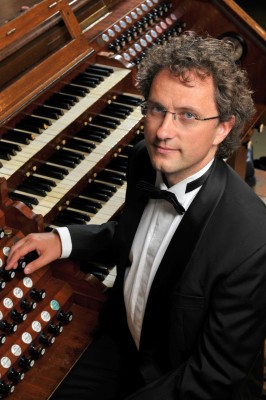Alfrēds Kalniņš. Organ music
Celebration of the release of the new CD and sheet music edition
Aigars Reinis (organ)
Programme: Alfrēds Kalniņš
Alfrēds Kalniņš (1879-1951), a doyen of Latvian music, was multifaceted: a composer, organist, conductor,
music critic, pianist and accompanist, teacher, and professor (from 1947) and rector (1944-1948) of the Latvian
State Conservatory. His son was the well-known composer and conductor Jānis Kalniņš (1904–2000).
Musicologist Arnolds Klotiņš called the composer “an artist endowed with the picturesque and poetic sense for
the nature of his homeland, who has left delicate national-style pieces in all musical genres.”
The composer wrote around 900 pieces in many varied genres, built the foundations for the Latvian National
Opera, made significant contributions to the solo song genre (his solo songs are included in the Latvian Cultural
Canon), and promoted the development of symphonic, choral, piano and organ music.
Kalniņš was born in Cēsis, where the music secondary school is now named after him. Organ music was always
a trusted part of his life. Significantly, the building where he was born is next to St. John’s Church. At the age
of ten, he began his journey as an organist at this church, playing hymns for the Latvian and German congregations.
His organ mastery was further developed at the Saint Petersburg Conservatory (1897-1901) under Louis
Homilius, although he never received his degree.
Kalniņš worked as a church and concert organist in Pärnu (Estonia, 1903-1911), Liepāja (1911–1915, 1918–1919)
and Tartu (Estonia, 1915–1918). As the organist of the Latvian St. Anne’s Church in Liepāja, he was the driving
force behind radical renovations and modernisation of the organ for concert needs. During the 1920s, he had an
intensive concert schedule in various Riga churches, giving around five solo organ concerts every season. During
this time, Kalniņš’ repertoire was already exceedingly broad, including the organ music of composers from many
eras and countries, from 17th century organ pieces which the artist liked to perform on the organs at Riga Dome
Cathedral and St. Peter’s Church, to contemporary music, for which the most suitable organ was that of Old St.
Gertrude’s Church. However, he performed most frequently on the organ of St. James Cathedral, Riga, where
he also played in services (1920–1923). As many of his contemporaries remember, Kalniņš’ talent was particularly
expressed in organ improvisations. Both in solo concerts and church services, his playing style was concert-
like and exceedingly supple. Despite his fame, Kalniņš regularly worked to improve his playing technique.
During his years in the U.S., Kalniņš played the organ at the Lutheran Christ Church in the centre of New York
City (1928–1933) and taught organ at a private conservatory. During this time, he was introduced to American
organ culture, hearing the playing of many organists in New York, Chicago and Philadelphia. His name as a
soloist and improviser spread quickly among church organists. He became a member of the American Guild of
Organists and National Association of Organists, took part in an organists’ congress in New York, and wrote
pieces which entered the repertoire of American organ virtuosos. In 1933, Kalniņš became the organist at Riga
Dome Cathedral and performed weekly organ concerts on the Latvijas Radiofons radio station (these took
place on and off until 1945).
/Mārīte Dombrovska/
Supported by VKKF, in cooperation with the Latvian Music Information Center, publishing houses "Skani" and "MusicaBaltica"









